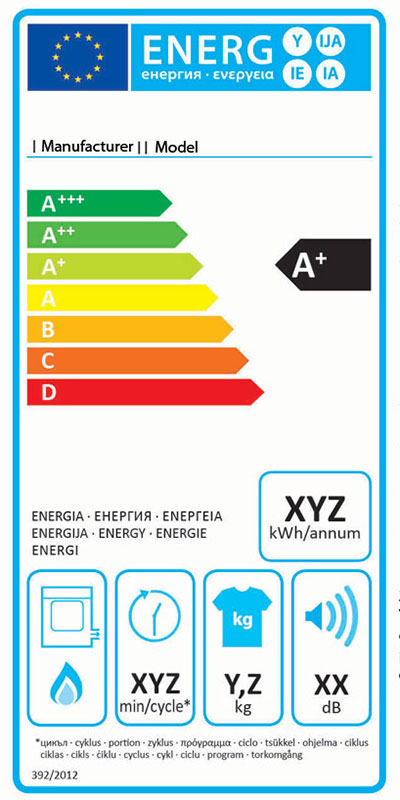Understand the energy saving ratings on appliances
When shopping for household electrical appliances, Vietnamese consumers have not paid much attention to the cost of operating products, including the cost of electricity consumption. The same type of household products with the same price but each product will have different energy consumption depending on the manufacturer, the technology applied. This can be found right on the stickers affixed to the device.
Choose a device with high energy efficiency
Household electrical appliances such as televisions, refrigerators, washing machines, microwaves, ovens . are the main things that consume energy in your home, so choosing the most energy efficient devices has Can save you the cost of owning the product.
In some countries such as the US, Australia, and Europe, Energy Energy labeling programs are available to help customers choose energy-saving equipment and they apply to both electrical and gas appliances. .
In Vietnam, according to the energy labeling roadmap, enterprises manufacturing and importing household appliances such as lighting equipment, air conditioners, refrigerators, washing machines, electric rice cookers, electric fans . are encouraged to paste Voluntary energy label before July 1, 2011. By January 1, 2013, energy labeling for these products is required. Office and commercial equipment such as photocopiers, computer power supplies, commercial refrigeration cabinets and other energy consumption devices are encouraged to voluntarily label energy labels before January 1, 2014 and mandatory. implemented from 1/1/2015.
Currently, most of the regulated items are labeled with energy, but consumers have not paid much attention or understood the information on the label. The article outlines some of the major energy labeling programs in the world, most of which are applicable for reference.
Australian energy labeling program
Australia's energy labeling program divides two types of energy labels for electrical appliances and gas appliances.
Electric energy labels are posted on TVs, air conditioners, clothes dryers, dishwashers, washing machines, refrigerators and freezers. There are two labels: 6-star standard labels and 7-10-star stickers for devices with higher energy efficiency. These labels show how energy efficient devices use, how much energy they use in a year. The more stars it means, the more energy-efficient the device is rated than other models, which use less energy and save energy. However, the numbers on the energy label are the average energy consumption, you need to consider your energy use may be different from this average.

You can refer to energy label information on the Australian Government Energy Ratings website when you need to compare electrical equipment that meets Australian energy saving standards. When comparing devices, make sure you compare models with the same size, volume and volume.
With gas appliances, energy labels are posted on gas heaters, gas water heaters, but this program is voluntary so not all manufacturers label gas energy labels. The gas energy label, if any, displays a star indicating energy efficiency and clearly indicates the number of Megajoule (MJ) energy consumed each year. The more efficient the device uses gas, the lower the number of MJ and the more stars.
US Energy Star Program

ENERGY STAR® is the US Environmental Protection Agency's energy labeling program, used by a number of countries, including Australia. Products are granted an Energy Star label if they meet the energy efficiency requirements of the Energy Star set of parameters. Typically, Energy Star labels are found on items such as computers, televisions, printers, photocopiers and DVD players. These labeled products mean it is more energy efficient than non-label products at least 20% of the power consumption.
European energy label system

There are three energy efficiency information you can find on the European energy label system:
1 . Energy efficiency rating: divided into levels A +++, A ++, A +, A, B, C, D, in which products labeled A +++ have the highest energy efficiency, the lowest is the product labeled D.
2 . Annual energy consumption: this level is specified in kWh units, calculated based on EU-defined and published standards. For example, in the image above is the energy label affixed to a clothes dryer, the annual power consumption (XYZ) is calculated according to the program of drying cotton clothes with full or half load.
3 . Specific product information: you can find some additional images related to the product, such as volume, water consumption and noise level.
The European energy labeling system is applied on products: washing machines, drying machines, dryers (clothes), refrigerators, freezers, dishwashers, electric cookers, air conditioners, balls. energy saving lamp.
Shopping for energy-saving products
All major household products have an obligation to label energy, if you can't find it, you should ask the seller clearly.
If you are comparing two devices with the same energy label, the same example with label A, take a closer look at the energy consumption data to determine which device uses less electricity.
Other details on energy labels are also very useful - like washing machine capacity, noise level - also a reference source for you to compare between different products.
- Build the first energy-efficient home in 2013
- Energy saving market in Vietnam is prospering
- Energy saving exam in the building
- Energy saving solutions for universities
- The brain also has an energy saving mode
- New generation super energy vehicles
- Signing to promote energy saving activities
- VN-Venezuela produces electricity-saving light bulbs
- You may not know the true meaning of the invention of these 5 familiar widgets
- Smart power saving device
- 6 mistakes when using electrical appliances can make you pay for your life
- Americans want to save energy
 'Fine laughs' - Scary and painful torture in ancient times
'Fine laughs' - Scary and painful torture in ancient times The sequence of numbers 142857 of the Egyptian pyramids is known as the strangest number in the world - Why?
The sequence of numbers 142857 of the Egyptian pyramids is known as the strangest number in the world - Why? History of the iron
History of the iron What is alum?
What is alum?